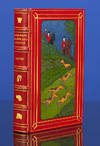![Imaging Intracellular Fluorescent Proteins at Nanometer Resolution in Science 313 No. 5793 pp. 1642-1645, September 15, 2006 [NOBEL PRIZE WINNING MICROSCOPY PAPER]](https://d3525k1ryd2155.cloudfront.net/h/143/602/1318602143.0.m.jpg)

Imaging Intracellular Fluorescent Proteins at Nanometer Resolution in Science 313 No. 5793 pp. 1642-1645, September 15, 2006 [NOBEL PRIZE WINNING MICROSCOPY PAPER]
by Betzig, E. [Eric], et al
- Used
- first
- Condition
- See description
- Seller
-
West Branch, Iowa, United States
Payment Methods Accepted
About This Item
Washington DC: The American Association for the Advancement of Science, 2006. 1st Edition. FIRST EDITION IN ORIGINAL PICTORIAL WRAPPERS OF A NOBEL PRIZE WINNING PAPER BY ERIC BETZIG. In 2014, Betzig, along with Stefan Hell and William Moerner, won the Nobel Prize in chemistry for figuring out a way to see single molecules, something most in the scientific community believed could never be done. Their work has allowed scientists "to see molecules in action within a living cell, watch DNA being put together, and follow the actions of proteins involved in Huntington's disease and Alzheimer's disease" (Fischman, Scientific American, October 8, 2014).
Optical microscopy has been "held back by a presumed limitation: that it would never obtain a better resolution than half the wavelength of light. Helped by fluorescent molecules the Nobel Laureates ingeniously circumvented this limitation;" their work has brought optical microscopy into the nanodimension" (Nobel Prize Committee).
Working independently, Betzig and Moerner, developed a technique called single molecule microscopy - the idea being to selectively turn on some fluorescent molecules in a sample, but leave others dark, then moving the focus slightly to adjacent molecules, and repeating. They "image[ed] the same area multiple times, letting just a few interspersed molecules glow each time. Superimposing these images yield[ed] a dense super-image resolved at the nanolevel... In 1997 Moerner showed he could hone in on just a single molecule, green fluorescent protein from a jellyfish, making it light up and go dark like a tiny lamp with a switch" (ibid). In 2006 and writing in this paper, Betzig actually utilized the method for the first time, showing "that after one molecule went dark, he could light up one nearby, and by superimposing the images, create a complete picture of part of a cell" (ibid). CONDITION & DETAILS: Washington DC: American Association for the Advancement of Science. 8vo. Original pictorial wrappers in pristine condition.
Optical microscopy has been "held back by a presumed limitation: that it would never obtain a better resolution than half the wavelength of light. Helped by fluorescent molecules the Nobel Laureates ingeniously circumvented this limitation;" their work has brought optical microscopy into the nanodimension" (Nobel Prize Committee).
Working independently, Betzig and Moerner, developed a technique called single molecule microscopy - the idea being to selectively turn on some fluorescent molecules in a sample, but leave others dark, then moving the focus slightly to adjacent molecules, and repeating. They "image[ed] the same area multiple times, letting just a few interspersed molecules glow each time. Superimposing these images yield[ed] a dense super-image resolved at the nanolevel... In 1997 Moerner showed he could hone in on just a single molecule, green fluorescent protein from a jellyfish, making it light up and go dark like a tiny lamp with a switch" (ibid). In 2006 and writing in this paper, Betzig actually utilized the method for the first time, showing "that after one molecule went dark, he could light up one nearby, and by superimposing the images, create a complete picture of part of a cell" (ibid). CONDITION & DETAILS: Washington DC: American Association for the Advancement of Science. 8vo. Original pictorial wrappers in pristine condition.
Reviews
(Log in or Create an Account first!)
Details
- Bookseller
- Atticus Rare Books
(US)
- Bookseller's Inventory #
- 1423
- Title
- Imaging Intracellular Fluorescent Proteins at Nanometer Resolution in Science 313 No. 5793 pp. 1642-1645, September 15, 2006 [NOBEL PRIZE WINNING MICROSCOPY PAPER]
- Author
- Betzig, E. [Eric], et al
- Book Condition
- Used
- Quantity Available
- 1
- Edition
- 1st Edition
- Publisher
- The American Association for the Advancement of Science
- Place of Publication
- Washington DC
- Date Published
- 2006
Terms of Sale
Atticus Rare Books
30 day return guarantee, with full refund including shipping costs for up to 30 days after delivery if an item arrives misdescribed or damaged.
About the Seller
Atticus Rare Books
Biblio member since 2010
West Branch, Iowa
About Atticus Rare Books
We specialize in rare and unusual antiquarian books in the sciences and the history of science. Additionally, we specialize in 20th century physics, mathematics, and astronomy.
Glossary
Some terminology that may be used in this description includes:
- Wrappers
- The paper covering on the outside of a paperback. Also see the entry for pictorial wraps, color illustrated coverings for...
- First Edition
- In book collecting, the first edition is the earliest published form of a book. A book may have more than one first edition in...

